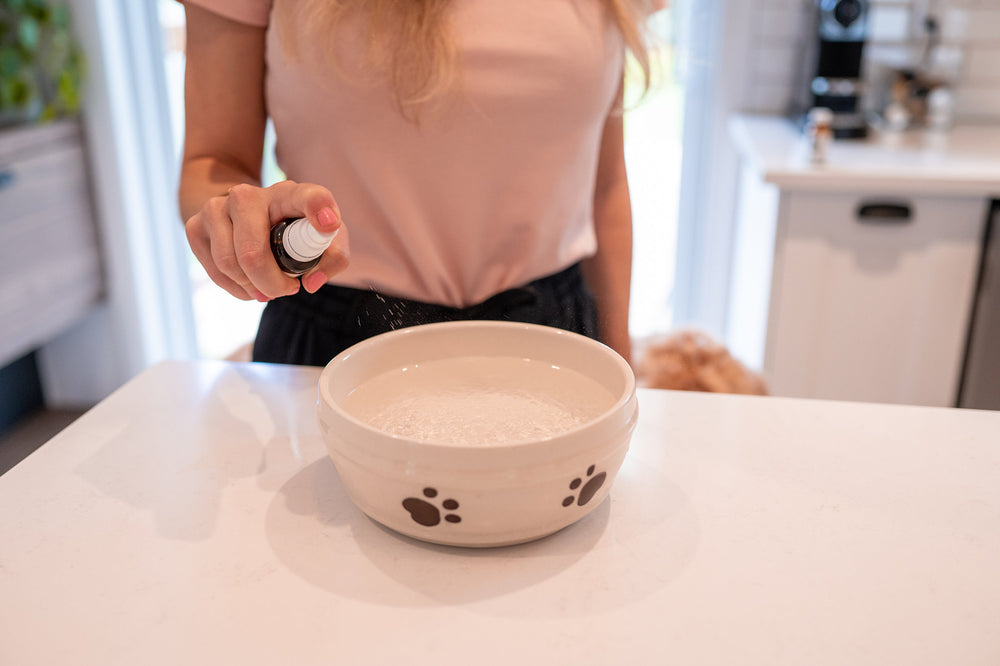How to Help Your Dog or Cat Lose Weight Safely

As both an animal homeopathy expert and a devoted dog mom, I've seen firsthand how many pet parents mistakenly equate excess weight with being "cute" or "fluffy." While being underweight is certainly concerning, carrying extra pounds can be just as dangerous, leading to serious health issues that can emerge sooner than many realize.
In this blog post, I’ll guide you through everything you need to know to help your cat or dog shed those extra pounds. You'll learn how to recognize the signs that your pet needs a weight loss plan, along with simple, practical tips to help them achieve a healthier weight.
Before we dive into the details, it’s important to start your cat or dog’s weight loss journey as early as possible. Achieving a healthy weight isn’t something that happens overnight—it takes patience and commitment. Ready to get started? Let’s dive in!
Pet Obesity Prevention: A Critical Duty for Responsible Owners
The Association for Pet Obesity Prevention reports that 61% of cats and 59% of dogs in the United States are overweight or obese. With more than half of our pets affected, it’s alarming to see how widespread this issue has become.
What's really interesting is that obesity is one of the most preventable problems affecting cats and dogs. Yet, it has become one of the most common health issues today. Without proper weight management, your pet could quickly become prone to serious health consequences.
As pet parents, it’s our duty to be mindful of our cat's or dog's weight. Excess pounds can trigger a host of health problems that not only diminish your pet's comfort and happiness but also shorten their life expectancy.
If your pet needs to shed excess weight, the best time to start is now. While obese dogs and cats may seem cute and fluffy, the health consequences can be serious and frightening. It’s important to recognize that as pet parents, we all play a role in our pet’s well-being—and it’s never too late to make a positive change.
Warning Signs That Your Cat or Dog Needs to Lose Weight

Beyond the obvious sign of extra weight, there are other key indicators of obesity that you should watch for. It’s crucial to consult a vet or pet wellness expert to help you get on the right track, especially if you’re unsure where to start.
The following signs indicate that your cat or dog needs to start losing weight as soon as possible:
- Clear visible signs of weight gain, such as a rounder body, fuller tummy, or thicker neck
- Difficulty moving or breathing, even after minimal physical exertion or activity
- A noticeable lack of energy, coupled with a tendency to sulk and hide instead of engaging in play or exercise
- Due to excess body weight, your dog or cat may have difficulty grooming itself
- Carrying extra weight increases vulnerability to frequent fatigue and joint injuries
Helping your cat or dog lose weight should start at the first signs of being overweight, not when the indicators become prominent. Although I don’t intend to alarm you, ignoring significant weight gain in your pet can quickly lead to serious health problems.
It’s crucial to remember that a proper weight loss plan for your cat or dog takes time to be effective. Rushing the process can endanger your pet’s life. That’s why it’s important to address this issue as early as possible.
Excess Weight in Pets Can Lead to Serious Health Problems
As mentioned earlier, significant weight gain can trigger health issues that negatively affect your cat's or dog's overall quality of life. Surplus weight can hinder essential activities like grooming and exercising and lead to the following health problems:
Joint health and mobility issues
For starters, a consistent increase in your dog's weight can put a lot of stress on their bones and joints, particularly the spine, making them prone to accelerated wear and tear. Failing to maintain your pet's target body weight can eventually lead to conditions such as arthritis or osteoarthritis.
Your dog's health can also be affected by the increased release of inflammatory cytokines, which not only cause bones and joints to stiffen but also alter their gait and posture, potentially leading to further mobility issues.
Besides making movement difficult, these cytokines can also slow down recovery from inflammation and related tissue damage, compounding the health challenges your dog may face.
Diabetes and digestive disorders
Excessive weight in your pet indicates an unhealthy amount of visceral fat, which can reduce insulin sensitivity and cause blood sugar spikes. Without a proper weight loss program, this may eventually lead to diabetes.
It’s important to recognize that diabetes exacerbates health issues like heart disease and eye problems. A diabetic dog or cat is significantly more prone to heart failure compared to its non-diabetic counterparts. Additionally, approximately 75% of diabetic dogs often become partially or totally blind without proper and immediate attention.
Additionally, surplus weight can severely disrupt the balance of beneficial bacteria in the gut, making digestion more difficult and potentially leading to health issues such as inflammatory bowel disease (IBD), gastroesophageal reflux disease (GERD), fatty liver disease, and pancreatitis.
Cardiovascular problems and decreased immunity
When your pet exceeds its ideal body weight, the heart becomes overworked as it struggles to circulate blood effectively, increasing the risk of conditions like hypertrophic cardiomyopathy. If left unaddressed, this can eventually lead to congestive heart failure.
In cats and dogs, obesity can trigger high blood pressure and arteriosclerosis, or hardening of the arteries, which together can increase the risk of stroke.
Moreover, excess weight can disrupt your pet's immune system, potentially preventing the production of antibodies and lymphocytes that fight infection and compromising its ability to manage inflammation. This significantly increases your pet's vulnerability to diseases, potentially reducing its lifespan.
Urinary tract infection and poor skin and coat health
The primary reason obesity leads to urinary tract infections (UTIs) in overweight or obese cats and dogs is that excess weight puts additional pressure on the bladder. This not only makes urination difficult but also prevents the complete expulsion of urine, creating an environment where bacteria can thrive. As bacterial levels increase, the likelihood of developing a UTI also rises.
Obese dogs and cats often struggle to groom themselves properly despite their desire to do so. This difficulty can lead to the accumulation of pathogens, stagnant urine, and irritants in areas like the folds of extra skin and fat. Without proper care and attention, these conditions can result in hotspots, bald patches, sores, and minor injuries, which may escalate into infections or chronic skin problems.
Cancer
As I mentioned earlier, obesity in dogs and cats compromises their immune system, leading to vulnerabilities such as chronic inflammation. This surplus weight not only disrupts hormone levels but also exposes them to oxidative stress, further weakening their overall health.
As an animal homeopathy expert and a dog mom, I must emphasize that cancer is one of the most devastating health issues your pet can encounter. Preventing oxidative stress is crucial to safeguarding their health.
Struggling to Help Your Cat or Dog Lose Weight?
Helping your cat or dog lose weight is a challenging task. Just like with humans, there’s no quick-fix weight loss strategy for pets. The process requires a well-planned routine, patience, and consistent effort. However, with dedication, you can achieve lasting results that will significantly improve your pet’s health.
I’d like to share some of the tips and tricks I've gathered over my years as an animal homeopathy expert. The best part is, you won’t need to rely on conventional veterinary medicines to make your pet weight loss plan successful. These natural strategies not only support weight loss but also contribute to your pet’s overall well-being.
In the next section, we’ll dive deeper into these tips and tricks to help your pet lose weight naturally.
6 Simple and Practical Tips to Help Your Pet Achieve Healthy Weight

Before we dive in, I want to remind you that there’s no such thing as a "rapid weight loss" plan for your obese dog or cat. Rushing the process won’t just lead to failure—it could also expose your pet to serious health risks. So, with that in mind, let’s get right to it.
#1. The first step to a successful weight loss program is appropriate portion control.
One of the main reasons dogs and cats gain weight is that their owners allow them to eat as much as they want. Whether it’s dog food or cat treats, some pet parents provide unregulated portions, resulting in excessive calories, more fat, and ultimately, obesity.
Always use a measuring cup when feeding your dog or cat. This simple step ensures you’re providing the correct portion size with ease, helping to manage your pet’s weight effectively. I also highly recommend measuring snacks and treats—even healthy treats can contribute to obesity if not given in controlled amounts.
It’s also important to ensure the food bowl is empty before serving your dog or cat their next meal. This encourages them to finish their meals before receiving more food, helping to prevent overfeeding.
#2. Feeding your pet human food can lead to extra pounds.
Pet food and human food are not the same, even if they share some ingredients. Take your dog's food as an example. While it might contain ingredients found in human food, the proportions of nutrients, salts, sugars, and fats differ significantly.
Feeding your pet human food could result in either excessive intake of certain nutrients or dangerous deficiencies.
While giving your dog or cat human food occasionally isn’t a problem, making it a habit can lead to serious health issues. It’s also crucial to carefully choose the types of human food you share with your pets, as some can be toxic—such as foods containing xylitol, garlic, onions, or alcohol.
#3. Cutting back on cat or dog treats helps promote weight loss.
Similar to how you portion your cat's or dog's food, it's crucial to reduce snacks and treats when helping your pet lose weight. Some treats contain high levels of sugar and fat, which can contribute to weight gain. If left unchecked, this could lead to obesity.
Whether you feed your dog or cat healthy treats like vegetable-based chews or grain-free biscuits, it's crucial to closely monitor how much you give. You won’t help your pet lose weight if they’re unintentionally consuming extra calories from snacks and treats.
I highly recommend giving high-calorie treats only on special occasions, not with every meal. Allowing your pet to snack whenever they want will inevitably result in a few extra pounds. Instead, you can substitute low-calorie treats, such as small pieces of vegetables or specially formulated low-calorie chews, to keep your pet satisfied without the extra calories.
#4. Achieve safe weight reduction with increased exercise intensity.
Remember, more physical movement and exercise means burning more calories. If your cat or dog isn’t getting enough exercise or playtime, they’re likely to gain weight over time. You might be surprised at how quickly a few pounds can accumulate!
While many dogs and cats suffering from obesity should not be suddenly subjected to intense or strenuous activities due to the risk of serious health issues, starting with low-impact exercises can help your pet get on the right track.
Examples of these low-impact exercises include walking, swimming, scent training, playing with food puzzle toys, or engaging with wands, laser lights, and hide-and-seek games. Be sure to consider your pet’s age, as senior cats and dogs may not enjoy activities that are more suited to younger pets.
#5. Aim for gradual weight loss to ensure long-term success.
When it comes to weight loss in pets, "slowly but surely" should be your guiding mantra. Some people mistakenly believe that simply changing their dog's diet or making their cat engage in more physically demanding activities will be enough. However, a balanced approach that combines gradual dietary adjustments with appropriate exercise is key to achieving sustainable weight loss.
Drastically changing your pet's meals and portion sizes can lead to nutrient deficiencies and other issues, such as joint injuries. Remember, as I emphasized earlier, weight loss is a gradual process, not something that happens overnight. It requires patience and determination to achieve successfully.
#6. Consistency is crucial for a successful weight loss plan.
This is something many pet parents often overlook: supervising your pet's weight loss requires consistency. It’s not a one-time effort. Once you have strategies in place, such as a therapeutic weight loss diet and an exercise plan, it’s crucial that you commit to them until your dog or cat reaches—and maintains—their target weight.
For example, many dog owners tend to revert to old feeding habits once they see their pets starting to slim down. This approach can undermine all your hard work. You must stick to your strategies until the goal is fully reached to ensure long-term success.
Weight Loss May Impact Your Pet’s Immune Health
As I’ve pointed out previously, excess weight can significantly burden your cat’s or dog’s overall health. It not only affects your pet physically but can also lead to stress and decreased mental well-being. Additionally, your animal family member’s immune system may become compromised. That’s why it’s crucial to support and boost your pet’s immune system throughout the weight loss process.
Zumalka's IMMUNOPET is formulated to help increase hemoglobin levels and purify blood and lymph nodes. This premium natural product also enhances white blood cell count, strengthening the body’s ability to fight against various bacterial and viral infections.
A Final Word
Pet obesity is not something to overlook. It can seriously impact your cat’s or dog’s quality of life. While it’s easy to create weight loss plans, sticking to them is often the real challenge. I want to reiterate the importance of dedication and commitment when it comes to helping your pet achieve a healthier weight.
I’d love to hear your thoughts or questions in the comments section below. If you have any tips I may have missed, please feel free to share them as well. I hope you found this post helpful, and I look forward to seeing you in my next blog!







Hi Diane,
We are reaching out to you via private email so we can be of the best assistance possible. Hope to hear back from you soon !
Hi Guys, I would like to help my kitty lose weight. Do I need a consult for that, which I’m definitely happy to do.
Thanks
Diane
Hi Jennifer, I’m sorry to hear about your cat being stressed and in need of weight loss. We will for sure do our very best to help her feel and look much better soon. We are reaching out to you via private email so we can be of the best assistance possible.
Regards, HOMEOANIMAL
My cat is overweight. Moved and she is stressed in a small environment. Is there a remedy to slowly help her loose weight. Thanks.
Dear Reena,
Thank you for your message. We hope our article has given you some helpful tips to help your dog loose weight. Of course we are also happy to help in any other way possible. To this end, we have sent you a private email to get all the details so we can give your dog the most targeted treatment possible.
Warm regards,
Homeoanimal
Leave a comment